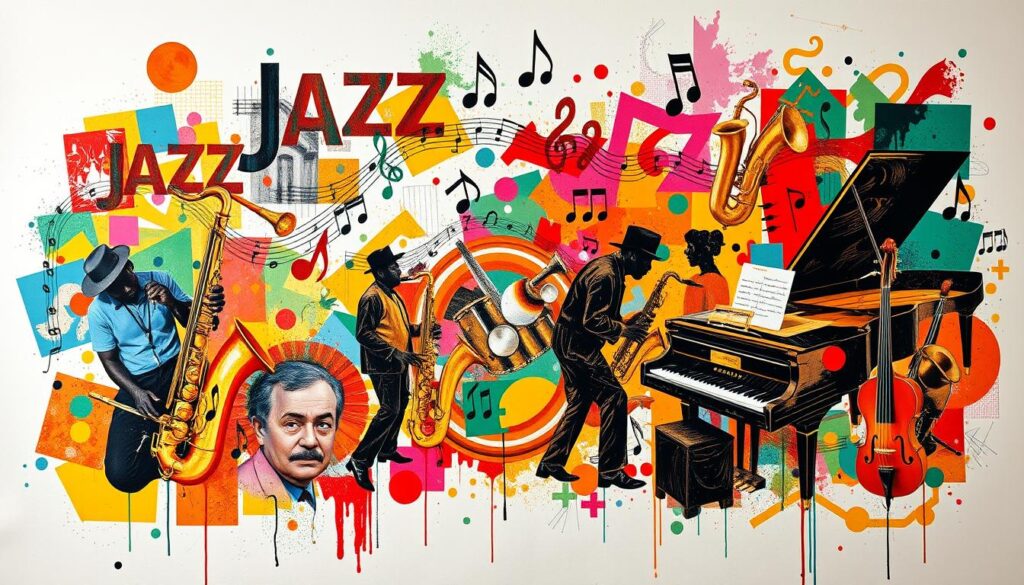Advertisements

What is the secret of jazz, a musical genre that originated in the United States? It conquered the world with its improvisation and complex rhythms. The history of jazz is rich and fascinating, showing how it became one of the most popular genres.
Imagine New Orleans, a vibrant city where cultures collide. This is where jazz was born. Its evolution over time showcases musical creativity and innovation.
The History of Jazz takes us to understand how the Origins of Jazz created a genre that still inspires.
Over time, jazz has evolved into a diverse and complex genre. But its essence remains: improvisation, creativity, and passion. In this journey, we will explore how the origins of jazz shaped a genre that enchants and inspires the world.
The emergence of Jazz in the early 20th century
Jazz emerged from the mixture of African, European and American influences. New Orleans was essential in this process. It was a meeting point for people from different cultures. There, a new musical style was born, which mixed blues, ragtime, gospel and European classical music, creating Jazz Styles unpublished.
Advertisements
To the Jazz Influences are clear in their evolution. With the union of cultures, jazz has become rich and diverse. Important factors for its emergence include:
- African influences, such as rhythms and melodies brought by African slaves;
- European influences, such as classical music and folk;
- The mixture of musical styles, such as blues, ragtime and gospel.
This mixture created a unique musical genre, jazz. Over time, jazz spread throughout the world. Today, it is one of the most popular genres of all time.
African and European influences
African and European influences were essential to jazz. African slaves brought their rhythms and melodies. These were mixed with European classical and folk music, creating jazz.
Advertisements
The role of New Orleans
New Orleans was crucial to jazz. It was a meeting place for people from different cultures. It was there that jazz developed as a unique musical genre.
The mix of musical styles
The blending of musical styles was fundamental to jazz. The genre emerged from the combination of blues, ragtime, gospel and European classical music. This resulted in Jazz Styles unpublished.
Jazz Pioneers and Their Contributions
Jazz is a musical genre with a long history. It began in the 20th century. Musicians such as Louis Armstrong, Duke Ellington and Billie Holiday were essential to its growth. They brought new techniques and styles that changed jazz.
Many talented musicians have helped to evolve jazz. They have brought their experiences and influences to the genre. Some of the main pioneers include:
- Louis Armstrong, known for his improvisational skills and his ability to create complex melodies
- Duke Ellington, who expanded the jazz orchestra and created masterpieces such as “Take the A Train” and “Mood Indigo”
- Billie Holiday, who brought a new dimension to songwriting with her soulful and expressive voice
The legacy of jazz pioneers is immense. They helped jazz grow and diversify. The evolution of jazz continues to this day, with new musicians and styles emerging.
The Swing Era and its popularity
Swing became a cultural phenomenon in the 1930s and 1940s. Bands like Duke Ellington and Count Basie led the movement. contemporary jazz was influenced by this style, known for its infectious rhythms and virtuoso solos.
You instruments in jazz were essential at that time. Saxophones, trumpets and pianos created a unique sound. Swing bands played in large dance halls, where people danced and had fun.
- Fast and contagious rhythms
- Virtuoso instrumental solos
- Use of instruments such as saxophones, trumpets and pianos
- Performances in large dance halls
Swing had a huge impact on popular music. It influenced the contemporary jazz and rock. To this day, swing is an important part of jazz history, inspiring many musicians and bands.
| Artist | Instrument | Contribution to Swing |
|---|---|---|
| Duke Ellington | Piano | He led one of the most famous swing bands |
| Count Basie | Piano | Developed a unique and influential swing style |
Bebop: a revolution in jazz
Bebop emerged in the 1940s, led by Charlie Parker and Dizzy Gillespie. It changed jazz, moving away from swing. It brought a new form of music, more experimental and improvised.
This change was crucial in History of Jazz. She changed how people saw and heard music.
The bebop style became more complex, both in rhythm and harmony. This made jazz a challenge for musicians and a pleasure for listeners. Origins of Jazz was the starting point for this musical journey.
With bebop, musicians began to explore new possibilities. They created a more complex and sophisticated sound. This required technical skill and creativity to improvise and create complex melodies in real time.
Charlie Parker and Dizzy Gillespie
Charlie Parker and Dizzy Gillespie were essential to bebop. Their contributions were fundamental to jazz music. They defined the sound of bebop and laid the foundation for new styles and subgenres.
- Rhythmic and harmonic complexity
- Improvisation and creativity
- Use of unconventional scales and modes
- Emphasis on technique and musical ability
In short, bebop was a revolution in History of Jazz. It shaped the sound and style of jazz music. To this day, it continues to influence musicians and composers, with its roots in Origins of Jazz.
Jazz and its cultural implications
Jazz has always been more than entertainment. It has been a tool of expression and a vehicle for social commentary. From New Orleans through the 1960s, jazz has played an important role in social and cultural issues.
THE Impact of Jazz on Society It is evident. It has influenced culture and society. Contemporary jazz shows this, with artists innovating and keeping the genre alive.
Jazz as a form of expression
Jazz allows you to express your emotions and ideas in a unique way. Musicians have the freedom to improvise and create. This allows them to share their experiences in a personal and universal way.
The relationship with social movements
The relationship between jazz and social movements is complex. Jazz has been used to criticize social injustices. Many artists have been inspired by movements such as the Civil Rights Movement in the US.
Some examples of jazz influence include:
- Challenging social and cultural norms
- Promote equality and justice
- Inspire creativity and innovation
In short, jazz had a Impact of Jazz on Society deep. The Contemporary jazz continues to be a vibrant form of expression and social commentary.
The subgenres of jazz
Jazz is a musical genre full of variety. It has several subgenres, each with its own influences. These subgenres showcase the creativity and improvisation of jazz.
Jazz subgenres reflect the influences that have shaped the music. From cool jazz to hard bop, each has its own sound and style. This shows the diversity and creativity of jazz.
Cool jazz and hard bop
Cool jazz is smooth and relaxed, while hard bop is intense and energetic. These subgenres show how jazz influences have created different sounds.
Jazz fusion and its modern influences
Jazz fusion blends jazz with rock and funk. This blend shows how jazz has evolved and continues to influence music today.
In short, jazz subgenres showcase the diversity and creativity of the genre. From cool jazz to jazz fusion, each offers a unique insight into jazz’s influences. And how they continue to shape the music.
Jazz in the contemporary era
Contemporary jazz is a vibrant musical genre. Artists from all over the world are helping to grow it. The digital age has made music easier to produce and share than ever before.
Artists use Instruments in Jazz modern to create new sounds. They mix different styles of music in innovative ways. This attracts a new generation of fans, who want to hear exciting and innovative music.
Current artists who stand out
- Kamasi Washington
- Robert Glasper
- Cecile McLorin Salvant
These artists are changing jazz. They use elements of Contemporary jazz and Instruments in Jazz in their music. With the help of digital technology, they can work together and share their music with the world. This has created a stronger and more vibrant jazz community.
The impact of digital on jazz
The digital age has changed how jazz is made, distributed, and heard. Streaming platforms and social media help artists reach more people. They can connect with fans from all over the world.
| Platform | Description |
|---|---|
| Spotify | Music streaming platform |
| Social network for sharing visual content | |
| YouTube | Video sharing platform |
These platforms are essential for jazz artists. They allow them to share their music, connect with fans, and promote their work effectively.
Application

Spotify
Where to listen to jazz?
Nowadays, it’s easy to find jazz thanks to streaming platforms and specialized radio stations. Whether you love jazz or are just starting out, there are plenty of options for you. This music is rich and engaging, and you can explore it endlessly.
Platforms like Spotify, Apple Music and Amazon Music have many jazz albums. You can find everything from classics to new releases. This way, you can discover the contemporary jazz and new artists who are doing the impact of jazz on society today.
There are also jazz-focused online radio stations, such as Jazz FM and NPR Jazz. They have a wide range of programming. This helps you discover new artists and styles, expanding your musical tastes.
Don't miss live jazz performances. Many cities have jazz clubs and bars. There, you can see both famous and new musicians. These performances are special because you can feel the energy of live music.
But, if you want to know more details about the platforms to listen online, check out our article below.
Recommended Content
